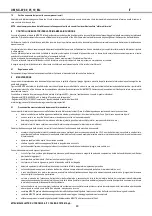
UM_NX-W_00_05_19_ML
EN
MITSUBISHI ELECTRIC HYDRONICS & IT COOLING SYSTEM S.p.A.
37
Translation of the original instructions
5.2
Clearance
Observe the clearances indicated in the dimensional drawing
Guarantee flooring in the entire clearance area around the unit at the same level as the base of the same unit.
Warning:
•
When the unit is in its final position and full of water, adjust the jacks of the vibration dampers.
5.3
Checking that compressors are secured in position
When the compressors are installed on spring vibration dampers, remove the block before start-up observing the instructions in the vicinity of the compressor.
5.4
Place of installation
The unit must be installed according to the requirements of standard EN 378-3 and the local regulations in force, in particular taking into account the category of occupation of
the premises and the safety class defined by EN 378-1
R134a
R1234ze
R1234yf
R513A
R410A
R404A
R407C
R454B
R32
safety class
A1
A2L
A2L
A1
A1
A1
A1
A2L
A2L
Tab.3
5.5
Storage
Before storing the unit it is necessary to empty the water circuit to avoid the danger of freezing in negative temperatures.
If the unit is to be put in storage for a long time, it is advisable to dry the heat exchangers and pressurise them with nitrogen to prevent humidity from lingering in the hydraulic
circuit.
6
HYDRAULIC CONNECTIONS
The following requirements apply to all hydraulic circuits connected to the unit. The connection pipes must be suitably supported so that they do not weigh down on the unit. Avoid
rigid connections between the machine and the pipes, and install vibration dampers.
For temperatures, minimum and maximum fluid flow rates and the content of fluid in the heat exchanger hydraulic circuit refer to the unit bulletin or ask the supplier. These
indications must be respected both when the unit is working and when it is switched off.
Protect the hydraulic circuit with an anti-freeze mix when the room temperature can drop below zero or eliminate all the fluid in the exchangers and in the lowest points of the
hydraulic circuit.
Tab.4
For units with different anti-freeze mixtures contact the manufacturer or MEHITS.
Any heating elements installed to prevent the pipes from freezing must be kept away from devices, sensors and materials that the heating elements could damage or cause to
malfunction (for example, temperature sensors, plastic components and power cables).
The temperature of the fluid at the machine outlet must always respect, even during the start-up phase, the work field envisaged by the manufacturer. For that purpose a by-pass
valve and/or other system devices can be inserted on the hydraulic circuit.
The water system of the units must be designed in such a way as to guarantee that, in all working conditions, the fluid circulating in the primary circuit remains within the minimum
limit set down in the technical bulletin of the unit.
If the unit is not equipped with a device for controlling the flow of vector fluid, it is necessary to guarantee that this is kept constant.
The vector fluid must never flow backwards in the water circuits. This could damage the pumps and cause bypassing, compromising the capacity and temperature of the plant.
When several machines are installed in parallel:
•
prevent the back-flow of vector fluid, particularly when the machines are turned off; one way to do this is to fit non-return valves or other suitable devices on the water
circuit, specifically on the delivery side of the pumps or machines; units fitted with several separate pumps in parallel have check valves on the delivery side of the
pumps for this reason, but it is important to check that this is not the case for twin pumps
•
reduce the overall flow and shut off the flow to machines that are turned off in order to prevent mixing of fluids at different temperatures that can affect performance
and the operating limits
Check that the fluid contained in the hydraulic circuit respects the following characteristics for the whole lifetime of the system:
Description
Symbol
Value
1
Concentration of hydrogen ions
pH
7.5
÷
9
2
Presence of calcium (Ca) and magnesium (Mg)
Hardness
4
÷
8.5 °D
Freezing temperature
°C
0
-5
-10
-15
-20
-25
-30
-35
ETHYLENE GLYCOL
Percentage in weight
%
0
12
20
30
35
40
45
50
































